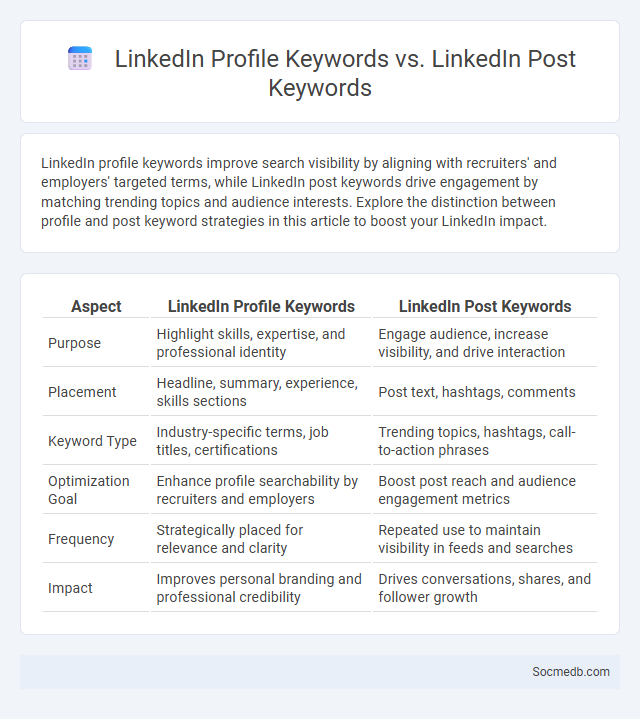
Photo illustration: LinkedIn Profile Keywords vs LinkedIn Post Keywords
LinkedIn profile keywords improve search visibility by aligning with recruiters' and employers' targeted terms, while LinkedIn post keywords drive engagement by matching trending topics and audience interests. Explore the distinction between profile and post keyword strategies in this article to boost your LinkedIn impact.
Table of Comparison
| Aspect | LinkedIn Profile Keywords | LinkedIn Post Keywords |
|---|---|---|
| Purpose | Highlight skills, expertise, and professional identity | Engage audience, increase visibility, and drive interaction |
| Placement | Headline, summary, experience, skills sections | Post text, hashtags, comments |
| Keyword Type | Industry-specific terms, job titles, certifications | Trending topics, hashtags, call-to-action phrases |
| Optimization Goal | Enhance profile searchability by recruiters and employers | Boost post reach and audience engagement metrics |
| Frequency | Strategically placed for relevance and clarity | Repeated use to maintain visibility in feeds and searches |
| Impact | Improves personal branding and professional credibility | Drives conversations, shares, and follower growth |
Understanding LinkedIn Profile Keywords
Understanding LinkedIn profile keywords is essential for enhancing your visibility in recruiter searches and improving your chances of landing job opportunities. Incorporate industry-specific terms, skills, job titles, and certifications relevant to your expertise throughout your headline, summary, and experience sections. Your strategic use of keywords boosts LinkedIn's algorithm in matching you with suitable roles and professional connections.
The Role of Keywords in LinkedIn Posts
Keywords in LinkedIn posts significantly improve your content's visibility by aligning it with LinkedIn's search algorithms and user queries. Strategically incorporating industry-specific terms and trending phrases helps you connect with the right audience, enhancing engagement and professional networking opportunities. Optimizing keywords in your posts positions you as a thought leader in your field, increasing the chance of career growth and business development.
Differences Between Profile and Post Keywords
Profile keywords represent essential terms linked to a user's identity, interests, and expertise, shaping how algorithms categorize and recommend their content. Post keywords are specific to individual updates or messages, targeting timely topics, trends, or conversations to boost visibility and engagement. Distinguishing between these keywords helps optimize social media strategies by aligning long-term branding with real-time interaction.
Importance of Keyword Optimization on LinkedIn
Keyword optimization on LinkedIn significantly enhances your profile's visibility in search results, attracting recruiters and potential clients. Using industry-specific keywords aligned with your skills and experience improves your chances of appearing in relevant searches and connecting with your target audience. By strategically incorporating keywords into your headline, summary, and job descriptions, you increase the likelihood that your profile resonates with LinkedIn's search algorithm and reaches the right professionals.
How to Research Effective LinkedIn Keywords
Researching effective LinkedIn keywords involves analyzing job descriptions, competitor profiles, and industry-specific terminology to identify high-impact phrases relevant to your career goals. Utilize LinkedIn's search bar and analytics tools to test keyword effectiveness in profile visibility, endorsements, and recruiter engagement. Incorporate a mix of hard skills, soft skills, and role-specific jargon to optimize search algorithms and enhance professional networking opportunities.
Optimizing Your LinkedIn Profile for Search
Optimizing your LinkedIn profile for search involves strategically using keywords relevant to your industry and expertise to improve visibility in recruiter and employer searches. Include specific skills, certifications, and job titles that align with your professional goals to enhance your profile's ranking on LinkedIn's algorithm. Your headline, summary, and experience sections should be rich with targeted terms that match the roles or connections you aim to attract.
Best Practices for Using Keywords in LinkedIn Posts
Incorporate relevant industry-specific keywords naturally within LinkedIn posts to enhance visibility and attract targeted audiences. Utilize keywords in headlines, summaries, and hashtags to improve searchability and engagement rates. Consistently analyzing LinkedIn analytics helps refine keyword strategies for maximum reach and professional impact.
Common Keyword Mistakes to Avoid on LinkedIn
Using overly generic terms like "hardworking" or "motivated" on LinkedIn can dilute Your professional profile and reduce visibility in search results. Avoid keyword stuffing, which can make your summary appear spammy and decrease engagement from recruiters. Instead, incorporate specific industry-relevant skills and job titles to optimize your LinkedIn presence and attract the right connections.
Tools for LinkedIn Keyword Optimization
Tools for LinkedIn keyword optimization include LinkedIn's own search analytics, which provides insights into popular keywords used in profiles and job postings. Third-party platforms like Jobscan and Resume Worded analyze LinkedIn profiles to suggest relevant keywords that improve visibility in recruiter searches. Utilizing keyword generators and AI-powered content tools helps tailor profile summaries, skills, and experience sections to match industry-specific search trends.
Measuring the Impact of Keyword Strategies on LinkedIn
Measuring the impact of keyword strategies on LinkedIn involves analyzing engagement metrics such as profile views, connection requests, and post interactions to determine the effectiveness of targeted keywords. Utilizing LinkedIn analytics tools enables tracking keyword-driven increases in search appearances and content reach, providing data-driven insights for refining SEO tactics. Consistent optimization of keyword placement in headlines, summaries, and posts enhances visibility, attracting relevant professional audiences and boosting overall LinkedIn performance.
 socmedb.com
socmedb.com